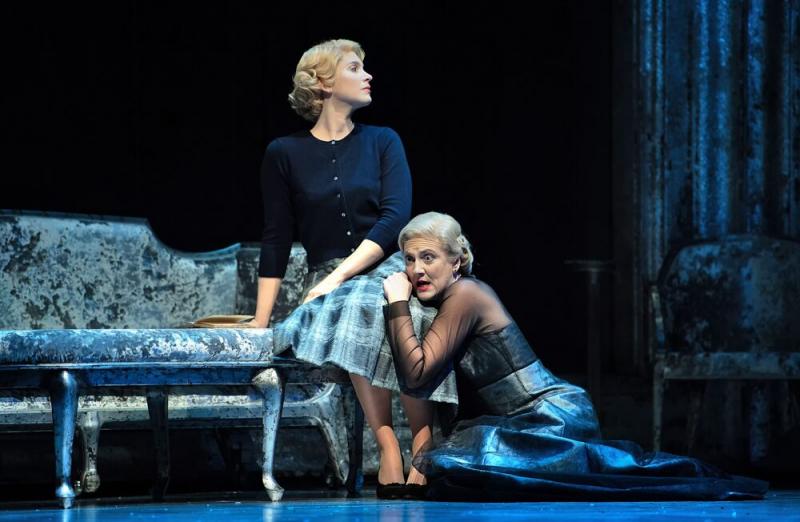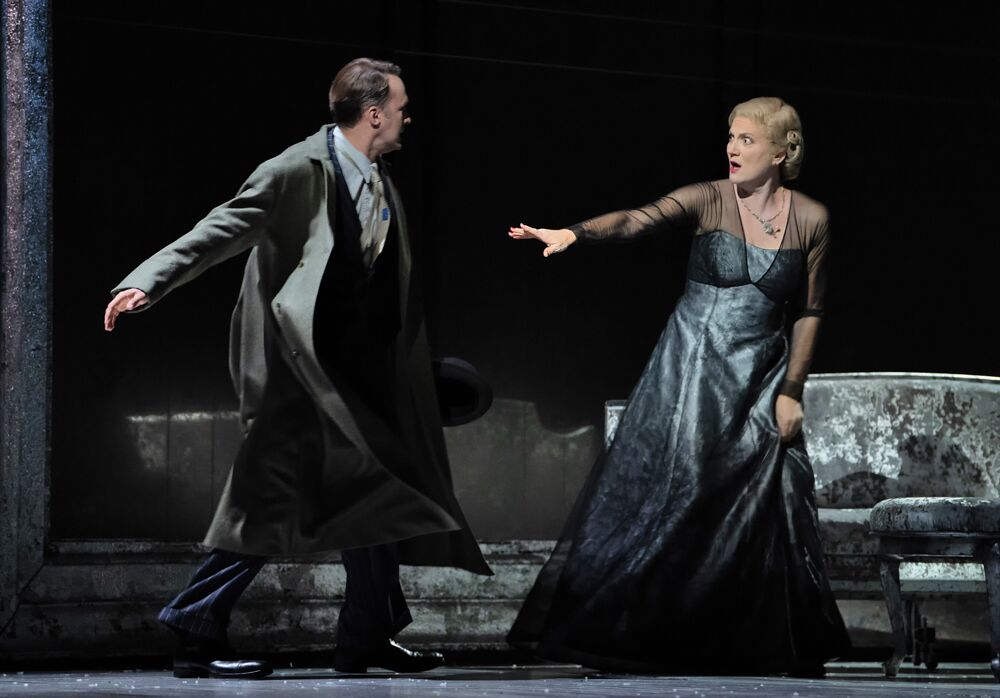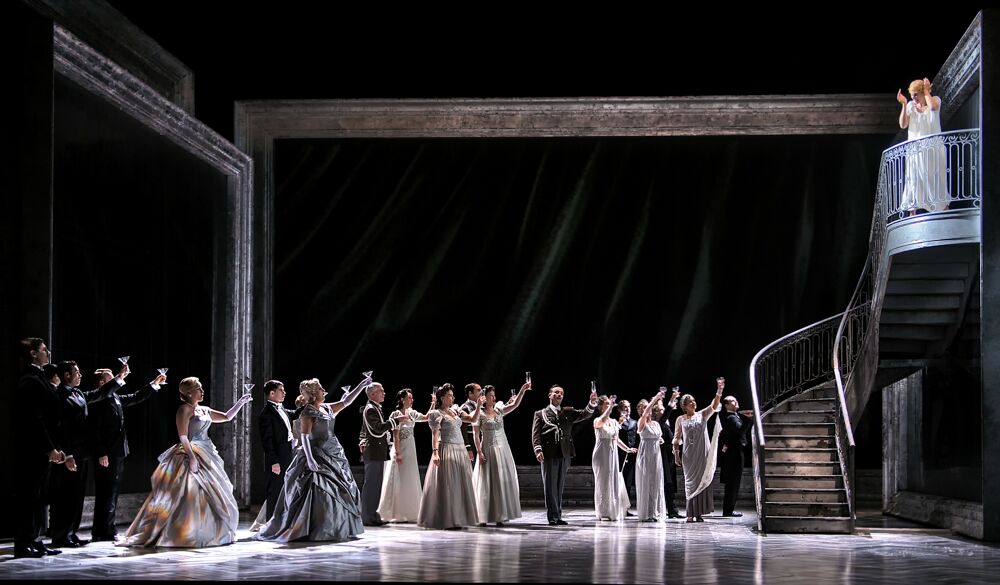Vanessa, Glyndebourne review - blowsy histrionics and a great finale | reviews, news & interviews
Vanessa, Glyndebourne review - blowsy histrionics and a great finale
Vanessa, Glyndebourne review - blowsy histrionics and a great finale
Does the end justify Barber's screamy little mystery, even when as well done as this?

"Sounds like an opera by Handel," said a friend when I told him that I was going to see Vanessa at Glyndebourne.
Much ink has been spilled over how Vanessa has suffered relative neglect because it came to light in a world, or at least a Europe, dominated by the Darmstadt-school avant-garde; its time has come, many say. But true tonally-based masterpieces of the 1950s – Stravinsky's The Rake's Progress, Britten's Billy Budd and The Turn of the Screw, Tippett's The Midsummer Marriage and Poulenc's Dialogues des Carmélites – have made their own way. Vanessa's real problem is that it starts at screaming pitch, both in the orchestra – those shrieking high woodwind – and the female voices, leaving the music-drama few places to go and our sympathy for the Gothic ladies untouched. Yes, it has one of the most mesmerising finales in opera, a canon-quintet which gives a wider context at last, and a couple of effective set-pieces along the way, but its substance feels ersatz, contrived; was it a work the composer had to write? Even this excellent production and the commitment of the performers didn't convince me so.  Middle-aged beauty Vanessa lives in a mansion somewhere in Northern Europe circa 1905 – Warner takes it back to America and updates to the time of the opera's composition – where she has dimmed the lights and covered the mirrors waiting for the return of the lover she last saw 20 years ago. In a neat little homage to Strauss's Arabella, it's his son of the same name who returns – or is it? He seduces her presumed niece on his first night as guest; the odd and sometimes compelling drama unfolds from that Liebesnacht. (Pictured above: Edgaras Montvidas as Anatol and Emma Bell as Vanessa)
Middle-aged beauty Vanessa lives in a mansion somewhere in Northern Europe circa 1905 – Warner takes it back to America and updates to the time of the opera's composition – where she has dimmed the lights and covered the mirrors waiting for the return of the lover she last saw 20 years ago. In a neat little homage to Strauss's Arabella, it's his son of the same name who returns – or is it? He seduces her presumed niece on his first night as guest; the odd and sometimes compelling drama unfolds from that Liebesnacht. (Pictured above: Edgaras Montvidas as Anatol and Emma Bell as Vanessa)
Warner has the clever idea of going against the mirror-covering and making this a drama of nothing but reflections. Ashley Martin-Davis's spare but haunting designs with their limited colour-palette work superbly – they would have given Stefan Herheim's ice-cold Glyndebourne production of Pelléas et Mélisande a better context than the organ-room facsimile we got there – and there's a further dimension in Alex Uragallo's black-and-white projections, moving in and out of focus. These also justify the 1950s setting; though Hitchcock mostly exploited technicolor in that decade, the thriller aspect is well observed. All the more pity, then, that Barber doesn't rise to the memorability of Bernard Herrmann's Hitchcock scores until the final scene (when Vertigo comes to mind).  Emma Bell and Virginie Verrez complement each other superbly as the two leading ladies, Bell's compellingly cloudy tone with its brilliant upper reaches is right for the older woman, Verrez sharing her intensity as the dramatic screw turns in the evening's second half. Edgaras Montvidas brings the original creator of the role of Anatol, Nicolai Gedda, to mind in the briefly memorable duet with Vanessa in Act II (though even this is defused by one of Menotti's typically overblown lines, "like the burning phoenix you flew out of the ashes of my shattered dreams"). The charmer remains a cipher, which is no doubt the point. Rosalind Plowright makes her presence felt in the vocally unrewarding role of the Old Baroness, Vanessa's mother, who sings only to those who connect to life. Donnie Ray Albert makes what he can of the Old Doctor, introduced a little too self-consciously for semi-comic relief.
Emma Bell and Virginie Verrez complement each other superbly as the two leading ladies, Bell's compellingly cloudy tone with its brilliant upper reaches is right for the older woman, Verrez sharing her intensity as the dramatic screw turns in the evening's second half. Edgaras Montvidas brings the original creator of the role of Anatol, Nicolai Gedda, to mind in the briefly memorable duet with Vanessa in Act II (though even this is defused by one of Menotti's typically overblown lines, "like the burning phoenix you flew out of the ashes of my shattered dreams"). The charmer remains a cipher, which is no doubt the point. Rosalind Plowright makes her presence felt in the vocally unrewarding role of the Old Baroness, Vanessa's mother, who sings only to those who connect to life. Donnie Ray Albert makes what he can of the Old Doctor, introduced a little too self-consciously for semi-comic relief.
No-one could make a better argument for the score than the magnificent and ever-collegial Hrůša; a focused London Philharmonic Orchestra burns for him and Glyndebourne is lucky to welcome back its former regular who has now shaped up as one of the world's great conductors. That he considered the score worth his time speaks well for it. The quirky woodwind solos and the weirdness of the forest music, the little patches of Puccinian lyricism and, of course, that final quintet are memorable and even ear-wormy. The party scene (pictured above) has its nightmarish quirks (though Blitzstein's in Regina, a more deserving opera adapted from Lilian Hellman's The Little Foxes, is better still). Too much, though, is crashing cymbals and overwrought screams, and do we care about any of the characters? Vanessa is no great beauty, and one hopes that next time Glyndebourne fills its rarity spot with something on a higher level.
The future of Arts Journalism
You can stop theartsdesk.com closing!
We urgently need financing to survive. Our fundraising drive has thus far raised £49,000 but we need to reach £100,000 or we will be forced to close. Please contribute here: https://gofund.me/c3f6033d
And if you can forward this information to anyone who might assist, we’d be grateful.

Subscribe to theartsdesk.com
Thank you for continuing to read our work on theartsdesk.com. For unlimited access to every article in its entirety, including our archive of more than 15,000 pieces, we're asking for £5 per month or £40 per year. We feel it's a very good deal, and hope you do too.
To take a subscription now simply click here.
And if you're looking for that extra gift for a friend or family member, why not treat them to a theartsdesk.com gift subscription?
more Opera
 La bohème, Opera North review - still young at 32
Love and separation, ecstasy and heartbreak, in masterfully updated Puccini
La bohème, Opera North review - still young at 32
Love and separation, ecstasy and heartbreak, in masterfully updated Puccini
 Albert Herring, English National Opera review - a great comedy with depths fully realised
Britten’s delight was never made for the Coliseum, but it works on its first outing there
Albert Herring, English National Opera review - a great comedy with depths fully realised
Britten’s delight was never made for the Coliseum, but it works on its first outing there
 Carmen, English National Opera review - not quite dangerous
Hopes for Niamh O’Sullivan only partly fulfilled, though much good singing throughout
Carmen, English National Opera review - not quite dangerous
Hopes for Niamh O’Sullivan only partly fulfilled, though much good singing throughout
 Giustino, Linbury Theatre review - a stylish account of a slight opera
Gods, mortals and monsters do battle in Handel's charming drama
Giustino, Linbury Theatre review - a stylish account of a slight opera
Gods, mortals and monsters do battle in Handel's charming drama
 Susanna, Opera North review - hybrid staging of a Handel oratorio
Dance and signing complement outstanding singing in a story of virtue rewarded
Susanna, Opera North review - hybrid staging of a Handel oratorio
Dance and signing complement outstanding singing in a story of virtue rewarded
 Ariodante, Opéra Garnier, Paris review - a blast of Baroque beauty
A near-perfect night at the opera
Ariodante, Opéra Garnier, Paris review - a blast of Baroque beauty
A near-perfect night at the opera
 Cinderella/La Cenerentola, English National Opera review - the truth behind the tinsel
Appealing performances cut through hyperactive stagecraft
Cinderella/La Cenerentola, English National Opera review - the truth behind the tinsel
Appealing performances cut through hyperactive stagecraft
 Tosca, Royal Opera review - Ailyn Pérez steps in as the most vivid of divas
Jakub Hrůša’s multicoloured Puccini last night found a soprano to match
Tosca, Royal Opera review - Ailyn Pérez steps in as the most vivid of divas
Jakub Hrůša’s multicoloured Puccini last night found a soprano to match
 Tosca, Welsh National Opera review - a great company reduced to brilliance
The old warhorse made special by the basics
Tosca, Welsh National Opera review - a great company reduced to brilliance
The old warhorse made special by the basics
 BBC Proms: The Marriage of Figaro, Glyndebourne Festival review - merriment and menace
Strong Proms transfer for a robust and affecting show
BBC Proms: The Marriage of Figaro, Glyndebourne Festival review - merriment and menace
Strong Proms transfer for a robust and affecting show
 BBC Proms: Suor Angelica, LSO, Pappano review - earthly passion, heavenly grief
A Sister to remember blesses Puccini's convent tragedy
BBC Proms: Suor Angelica, LSO, Pappano review - earthly passion, heavenly grief
A Sister to remember blesses Puccini's convent tragedy
 Orpheus and Eurydice, Opera Queensland/SCO, Edinburgh International Festival 2025 review - dazzling, but distracting
Eye-popping acrobatics don’t always assist in Gluck’s quest for operatic truth
Orpheus and Eurydice, Opera Queensland/SCO, Edinburgh International Festival 2025 review - dazzling, but distracting
Eye-popping acrobatics don’t always assist in Gluck’s quest for operatic truth

Add comment